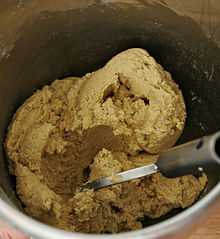Dough
- This article is about a cooking ingredient. For the British sitcom episode, see Dough (Bottom episode).

Dough (![]() pronunciation (help·info)) is a thick, malleable, sometimes elastic, paste made out of any cereals (grains) or leguminous crops. Dough is typically made by mixing flour with a small amount of water and/or other liquid, and sometimes includes yeast or other leavening agents as well as other ingredients such as various fats or flavorings.
pronunciation (help·info)) is a thick, malleable, sometimes elastic, paste made out of any cereals (grains) or leguminous crops. Dough is typically made by mixing flour with a small amount of water and/or other liquid, and sometimes includes yeast or other leavening agents as well as other ingredients such as various fats or flavorings.
The process of making and shaping dough is a precursor to making a wide variety of foodstuffs, particularly breads and bread-based items (e.g., crusts), biscuits, cakes, cookies, dumplings, flatbreads, noodles, pasta, pastry, pizza, pies, and similar items. This includes all kinds of breads or similar recipes made from maize, rice, sorghum, wheat, and other cereals or related crops used around the world.
Types of dough

Doughs vary widely depending on ingredients, the kind of product being produced, the type of leavening agent (particularly whether the dough is based on yeast or not), how the dough is mixed (whether quickly mixed or kneaded and left to rise), and cooking or baking technique. There is no formal definition of what makes dough, though most doughs have viscoelastic properties.[1]
Leavened or fermented dough, made from dry ground grain cereals or legumes mixed with water and yeast, are used all over the world to make various breads. Salt, oils or fats, sugars or honey and sometimes milk or eggs are also common ingredients in bread dough.
Flatbreads such as pita, lafa, lavash, matzah or matzo, naan, roti, sangak, tortilla, and yufka are made from dough and eaten in many parts of the world. Some flatbreads, such as naan, use leavening agents; others, such as matzo, do not. Crackers are also made from dough, and some (such as saltine crackers[2]) are leavened.
Pasta and noodles are generally based on unleavened doughs that are worked until they are dry and smooth, and then shaped into their final form; these may be cooked immediately or dried before cooking.
Doughs with higher fat content develop less gluten, due to their lower water content and may be less elastic; these doughs are often called "short" by bakers, and include many cookie and pie crust doughs, such as shortcrust pastry.[1]
In many parts of central India, people use the quick method of making an instant roasted dough ball or baati. In countries in the Sahel region of Africa, dough balls called aiysh or biya are made from sorghum or millet, and are ground and boiled.
So-called quick breads use leavening agents other than yeast, and include most cookies, cakes, biscuits, and more; these may be based on a batter or a dough.
Techniques


Techniques used in dough production depend on the type of dough and final product.
For yeast-based and sponge (such as sourdough) breads, a common production technique is the dough is mixed, kneaded, and then left to rise. Many bread doughs call for a second stage, where the dough is kneaded again, shaped into the final form, and left to rise a final time (or proofed) before baking.[3] Kneading is the process of working a dough to produce a smooth, elastic dough by developing gluten.[3]
Pasta is typically made from a dry dough that is kneaded and shaped, either through extrusion, rolling out in a pasta machine, or stretched or shaped by hand (as for gnocchi or dumplings). Pasta may be cooked directly after production (so-called "fresh pasta") or dried, which renders it shelf-stable.
Doughs for biscuits and many flatbreads which are not leavened with yeast are typically mixed but not kneaded or left to rise; these doughs are shaped and cooked directly after mixing.
While breads and other products made from doughs are often baked, some types of dough-based foods are cooked over direct heat, such as tortillas, which are cooked directly on a griddle. Fried dough foods are also common in many cultures.
Pancakes, waffles, some kinds of bar cookies such as brownies, and many cakes and quick breads (including muffins and the like) are often made with a semi-liquid batter of flour and liquid that is poured into the final shape, rather than a solid dough. Unlike bread dough, these batters are not stabilized by the formation of a gluten network.[4]
See also
- Baking
- Dabby-Doughs, a form of pastry typically made with left-over doughs
- Farinograph
- Seed cake
- Slang terms for money
-
 Food portal
Food portal
References
- ↑ 1.0 1.1 Leon Levine; Ed Boehmer (1997). "Chapter 12, Dough Processing Systems". Handbook of Food Engineering Process. doi:10.1201/9781420049077.ch12.
- ↑ Ponte, J. G.; Payne, J. D.; Updated By Staff (2007). "Bakery Processes, Yeast-Raised Products". Kirk-Othmer Encyclopedia of Chemical Technology. doi:10.1002/0471238961.2505011916151420.a01.pub2. ISBN 0471238961.
- ↑ 3.0 3.1 Irma S. Rombauer; Marion Rombauer Becker; Ethan Becker (1997). Joy of Cooking. Scribner. pp. 738–742. ISBN 0684818701.
- ↑ Stanley P. Cauvain. (2012) Chapter 12: Baking. in Food Processing Handbook. 2 ed. Wiley. p. 422 ISBN 9783527324682. This reference is specifically about cake batter.
External links
 Dough at Wikibook Cookbooks
Dough at Wikibook Cookbooks The dictionary definition of dough at Wiktionary
The dictionary definition of dough at Wiktionary Media related to Dough at Wikimedia Commons
Media related to Dough at Wikimedia Commons
| ||||||||||||||||||||||||||
